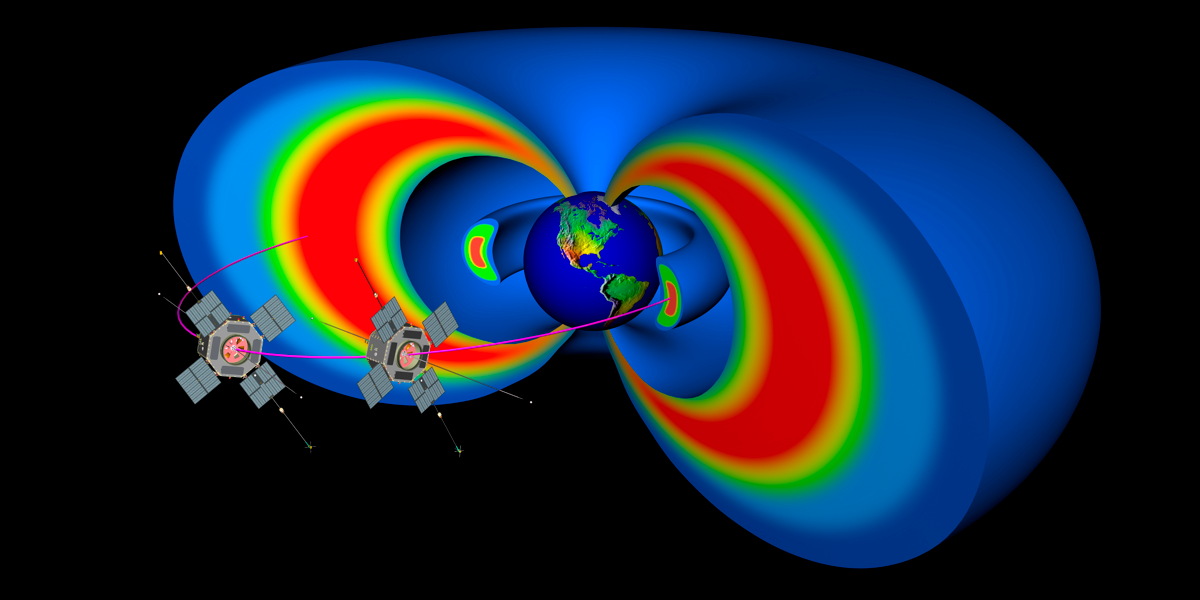'Zebra Stripes' in Earth's Magnetic Field Have Surprising Source

Strange stripelike features in Earth's magnetic field are caused by the planet's spin, and not by the constant bombardment of solar particles as previously thought, scientists say.
The so-called "zebra stripes" form when the electric field around Earth generated by the planet's rotation — previously thought to be too weak to impact the fast-moving particles — creates a striped pattern in the inner electron belt.
"Features similar to zebra stripes were previously inferred from low-altitude electron measurements," said lead study author Sasha Ukhorskiy of Johns Hopkins University Applied Physics Laboratory in Maryland. Ukhorskiy was the lead author of the new study that examined the patterns of charged particles and modeled their interactions with Earth's rotation. [Earth Quiz: Do You Truly Know Your Home Planet?]
The "zebra stripes" were previously thought to be caused by the changing flow of particles streaming from the sun.
"It is because of the unprecedented high energy and temporal resolution of our energetic particle experiment RBSPICE — part of the Van Allen Probes NASA mission — that we now understand that the inner belt electrons are, in fact, always organized in zebra patterns," Ukhorskiy told Space.com via email.
A striped shield
Earth's magnetic field surrounds the planet like a shield, protecting it from the constant bombardment of charged particles from the sun. A slight tilt in the axis of this field creates a weak electric field that permeates the inner radiation belt. The interaction between the two creates the zebra stripes, which are concentrated distributions of highly energetic electrons trapped in Earth's magnetic field. These features are invisible to the human eye.
Get the Space.com Newsletter
Breaking space news, the latest updates on rocket launches, skywatching events and more!
"If the inner belt electron populations are viewed as a viscous fluid — which is just an analogy — these global oscillations stretch and fold that field, much like taffy is stretched and folded in a candy-store machine," Ukhorskiy said. "This stretching-and-folding process results in the striped pattern across the entire inner electron belt."
Before this new finding, scientists had thought the field created by the planet's rotation was too weak to form the zebra stripes because it only changed the speed of the particles by 1 to 2 kilometers per second (0.6 to 1.2 miles per second) — which isn't much, considering the particles had been traveling at almost 100,000 km/s. Instead, the scientists attributed the formation of the features to interactions with the ever-changing solar wind and the presence of geomagnetic storms.
Working with a team of scientists, Ukhorskiy studied the data gathered by the Van Allen Probes to determine that the zebra stripes are a constant fixture in Earth's magnetic field, rather than features whose formation are dictated by the ever-changing presence of the solar wind.
"The fact that zebra patterns are observed — and are more clear — during intervals of quiet solar-wind conditions was the main indication that it must be the Earth's rotation that drives them," Ukhorskiy said.
The presence of the stripes only during calm periods was the first clue that the solar wind was not the driving force behind them. Ukhorskiy and his team went on to model the interactions between the magnetic field and the weak electric field generated by the planet's rotation. They concluded that this interaction created the zebra stripes.
Zebra stripes only form in the inner electron belt, which extends from Earth's atmosphere up to approximately 8,000 miles (13,000 kilometers) above the planet's surface. The outer electron belts take the brunt of the solar wind, making an unstable environment of competing processes.
The new findings were published online March 19 in the journal Nature.

Stripes in the solar system
Launched in 2012, the Van Allen Probes consist of two spacecraft located in the concentrated regions of Earth's electric field known as the Van Allen belts. The satellites study electrons in the radiation belt, and how their behavior changes over time and as a result of interactions with solar particles.
Although the radiation belt deflects most of the harmful material streaming from the sun, massive solar storms on the star occasionally hurl large quantities of material toward the planet that can affect satellites, communication systems and power grids. Understanding how Earth's shield interacts with these particles can help scientists gauge the measures needed to protect these systems.
Zebra stripes may surround other planets in the solar system. Ukhorskiy said the rotational forces of Jupiter and Saturn are far more prominent in affecting their plasma environments, making the concentrated pattern a likely feature in their radiation belts. Launched in 2011, NASA's Juno mission is set to reach Jupiter in July 2016, and should spot any zebra stripes in the gas giant's radiation belt.
When asked about the next step, Ukhorskiy said, "In my opinion, the most intriguing science question is whether similar or more prominent features exist at the outer planets."
Editor's Note: This story was updated April 4 to correct the institution for lead study author Sasha Ukhorskiy of Johns Hopkins University Applied Physics Laboratory in Maryland.
Follow us @Spacedotcom, Facebook and Google+. Original article on Space.com.
Join our Space Forums to keep talking space on the latest missions, night sky and more! And if you have a news tip, correction or comment, let us know at: community@space.com.

Nola Taylor Tillman is a contributing writer for Space.com. She loves all things space and astronomy-related, and enjoys the opportunity to learn more. She has a Bachelor’s degree in English and Astrophysics from Agnes Scott college and served as an intern at Sky & Telescope magazine. In her free time, she homeschools her four children. Follow her on Twitter at @NolaTRedd












